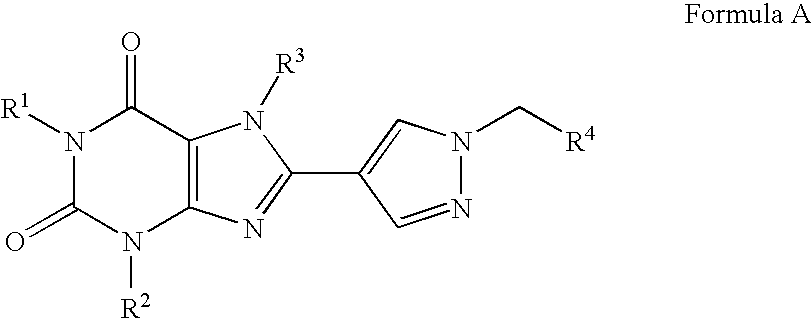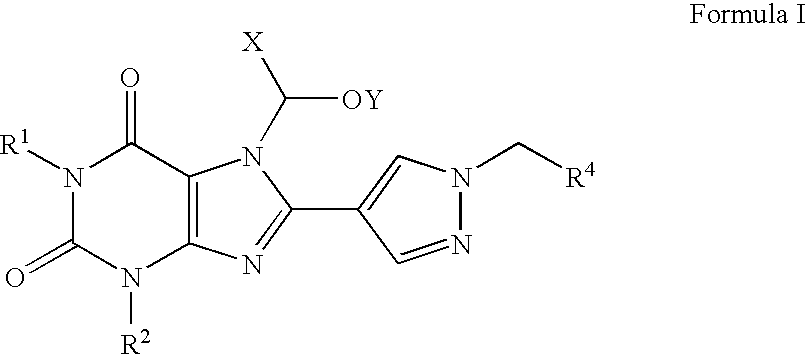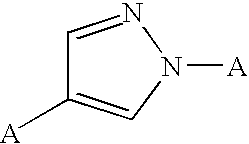Prodrugs of A2B adenosine receptor antagonists
a technology of adenosine receptor and adenosine, which is applied in the direction of biocide, group 5/15 element organic compounds, drug compositions, etc., can solve the problems of high plasma levels, potentially fatal complications, and unfavorable blood vessel increase, and achieve the effect of preventing the action of microorganisms
- Summary
- Abstract
- Description
- Claims
- Application Information
AI Technical Summary
Benefits of technology
Problems solved by technology
Method used
Image
Examples
example 2
Preparation of a Carbamate Derivative of a Compound of Formula (1)
Preparation of [3-ethyl-2,6-dioxo-1-propyl-8-(1-{[3-(trifluoromethyl)phenyl]methyl}-pyrazol-4-yl)-1,3,7-trihydropurin-7-yl]methyl 4-methylpiperazinecarboxylate
[0130]
[0131] Chloromethyl chloroformate (0.319 mmol) and 1-methylpiperazine (0.319 mmol) were mixed in N,N-dimethylformamide (2 ml) at 0° C. in the presence of potassium carbonate (1.325 mmol). After 1 hour, a precooled solution of 3-ethyl-1-propyl-8-(1-{[3-(trifluoromethyl)phenyl]methyl}-pyrazol-4-yl)-1,3,7-trihydropurine-2,6-dione (0.265 mmol) in N,N-dimethylformamide (1 ml) was added, and the mixture was stirred for 24 hours, allowing the temperature to rise to room temperature. Solvent was removed under reduced pressure, and the residue applied to a preparative thin layer chromatography plate, eluting with 5% methanol / methylene chloride, providing 150 mg of [3-ethyl-2,6-dioxo-1-propyl-8-(1-{[3-(trifluoromethyl)phenyl]methyl}pyrazol-4-yl)-1,3,7-trihydropuri...
example 3
Preparation of a Phosphate Derivative of a Compound of Formula (1)
Preparation of [3-ethyl-2,6-dioxo-1-propyl-8-(1-{[3-(trifluoromethyl)phenyl]methyl}-pyrazol-4-yl)(1,3,7-trihydropurin-7-yl)]methyl Dihydrogen Phosphate
[0132]
Step 1—Preparation of di-tert-butyl Chloromethyl Phosphate (Formula (2))
a) Preparation of di-tert-butyl hydrogen phosphate
[0133] To a stirred solution of bis(tert-butoxy)phosphino-1-ol (0.78 g, 4 mmol) and potassium bicarbonate (0.6 g, 2.4 mmol) in water (4 ml) at 0° C. was added (in portions) potassium permanganate (0.44 g, 2.8 mmol). The mixture was allowed to warm to room temperature, and stirred for 1 hour. Decolorizing charcoal (60 mg) was then added, and the mixture stirred at 60° C. for 15 minutes, and then filtered. The solid thus obtained was washed with water (30 ml), and the combined filtrates were treated with a further 100 mg of decolorizing charcoal at 60° C. for 20 minutes. The mixture was filtered, and the filtrate cooled to 0° C. and carefu...
example 4
Preparation of a Compound of Formula (1)
Preparation of a Compound of Formula I in which R1 is n-Pro yl, R2 is Ethyl, R4 is 3-Trifluoromethylphenyl, X is Hydrogen, and Y is n-Butanoyl
[0139] A. Preparation of chloromethyl pyridine-3-carboxylate
[0140] A mixture of nicotinic acid (200 mg, 1.6 mmol), sodium bicarbonate (540 mg, 6.4 mmol), and tetrabutylammonium sulfate (54 mg, 0.16 mmol) was dissolved in a mixture of 4 ml of dichloromethane and 4 ml of water, and cooled to 0° C. To this stirred mixture was added chloromethylchlorosulfone (165 μl, 1.6 mmol) in 1 ml of dichloromethane, and the mixture was allowed to warm to room temperature, stirring overnight. The organic layer was separated, washed with brine, dried over sodium sulfate, and concentrated under reduced pressure to a yellow oil, which was dissolved in dichloromethane and filtered through a silica plug. Removal of the solvent under reduced pressure provided chloromethyl pyridine-3-carboxylate (70 mg).
B. Preparation of ...
PUM
| Property | Measurement | Unit |
|---|---|---|
| temperature | aaaaa | aaaaa |
| temperature | aaaaa | aaaaa |
| temperature | aaaaa | aaaaa |
Abstract
Description
Claims
Application Information
 Login to View More
Login to View More - R&D
- Intellectual Property
- Life Sciences
- Materials
- Tech Scout
- Unparalleled Data Quality
- Higher Quality Content
- 60% Fewer Hallucinations
Browse by: Latest US Patents, China's latest patents, Technical Efficacy Thesaurus, Application Domain, Technology Topic, Popular Technical Reports.
© 2025 PatSnap. All rights reserved.Legal|Privacy policy|Modern Slavery Act Transparency Statement|Sitemap|About US| Contact US: help@patsnap.com



